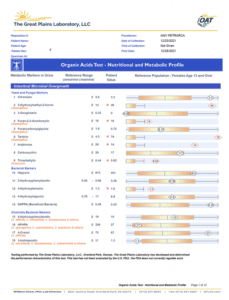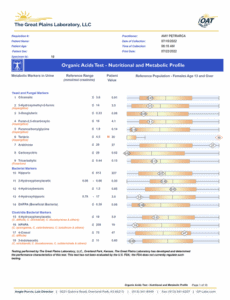SUMMARY
Functional medicine tests help practitioners learn what’s affecting their patients at a cellular level. Amy Petrarca, RN, shares the before and after Organic Acids Test reports, six months apart, that were pivotal in her treatment of a patient suffering from grief, Polycythemia Vera, mold exposure, and joint pain.
Sometimes hidden ailments not uncovered by traditional physicians can only be revealed by tried and true tests such as the Organic Acids Test (OAT) and a comprehensive stool analysis.
After years of caregiving for her father, Lori’s emotional, physical, and spiritual life had all but flatlined. When her father passed away, Lori decided to seek help for a new and threatening diagnosis of Polycythemia Vera, which she found terrifying. Her current clinical symptoms at that time included anxiety, depression, poor concentration, fatigue, joint pain, and decreased appetite.
One of Lori’s best friends referred her to work with a functional medicine provider, Amy Petrarca, MS, RN, L Ac, Dipl. OM, IFMCP, owner of BiaoHealth in San Francisco, California.
Lori was hopeful that Petrarca’s 25 years of experience in emergency nursing and more than 10 years of experience treating patients with functional medicine would be the right blend of experience to assist her with moving forward.
During their initial consult, Petrarca learned that Lori was grief stricken, depressed, and struggling with numerous imbalances including profuse itching and ocular migraines. She also had a history of kidney stones.
Lori shared her CBC bloodwork with Petrarca, which revealed elevated RBC and elevated Platelets – consistent with the diagnosis of Polycythemia Vera (PV), which is typically treated with Hydroxyurea, an oral chemotherapy agent – a medication that at the age of 65 terrified Lori.
A BATTERY OF DIAGNOSTICS REVEAL NEEDED ANSWERS

To gather more data, Petrarca ordered a Comprehensive Stool Analysis, Organic Acid Test, and Advanced Lipid Panel. The above sample reports showed what the OAT revealed to Petrarca initially and during a six-month follow-up.
Lori’s intake OAT revealed yeast, fungal, bacterial issues, specifically marker 54 showed evidence that yeast and mold were thriving inside her body. The OAT also showed indications of microbial and cellular stress to the mitochondria and high oxalates.
Lori worried that the higher level of oxalates on page three of her OAT may lead to future kidney stones and was concerned about the implications.
TREATMENT PROTOCOL
Petrarca focused on the core modifiable lifestyle variables at the bottom of the IFM MATRIX, which include stress, sleep/restoration, nutrition, relationships, and exercise/movement.
Petrarca then advised Lori to begin focusing on quality rest and relationships to assist her mind, body and spirit during the grieving process. Fortunately, Lori was also starting work with a mental health therapist to assist with these goals. Petrarca helped Lori support her health through leveraging the MATRIX – which included supplements to repair her gut, and support mitochondria to help her regain energy because Lori’s current diet was insufficient in nutrients as demonstrated in the OAT findings.
To help Lori mend emotionally, Petrarca also encouraged her to spend as much time as possible with supportive relationships in her life, including friends, her dog, and riding her horses and encouraged Lori to continue building a new wellness treatment team.
At the turn of the year, Lori was able to leave her primary health care doctor at Kaiser, and initiate care with a provider who she could choose that accepts Medicare patients.
Petrarca booked a scheduled clinical consultation with Jasmyne Brown, ND of GPL to collaborate on the initial and follow-up OAT findings.
During consultation with the patient where the initial OAT findings were revealed, Petrarca learned that Lori’s house was built over a creek and had cabinets that could be damp or moldy.
Here were Petrarca’s initial recommendations:
- Please continue with all previously recommended supplementation to date.
- OrthoSpore by Ortho Molecular – 1 capsule once per day.
- Acetyl-L-Carnitine – Lori mentioned that she can receive this as an injectable. If you cannot receive injectable – and/or you decide to go with the oral route, please alert me – and I can help you with a recommendation.
- Please discontinue Buffered Vitamin C for now.
- Please consider reading into and investigating mold as a major contributor to your situation. You could hire a mold inspector. Brown mentioned this resource: https://www.namri.org/index.php
- It is also possible to consider the MycoTOX Profile by Great Plains to do a “deeper-dive” into the mold picture, if you wish. Please fill out an MSQ now and then periodically, so we can monitor your progress.
6 MONTHS LATER, LOWER OXALATES

Lori felt substantially better after six months of therapy and functional medicine protocol adherence. She had stopped eating packaged food and started preparing meals with fresh vegetables. She had started remodeling her kitchen and finally was therapeutic on the Hydroxyurea pharmaceutical, after her fears and anxiety had dissipated – with the support of her new medical team.
Lori’s second OAT test revealed that her Oxalates had fallen from 105 to 86 (Marker 21). Her mitochondria markers had returned to normal range and her hydroxmethyl-2 furoic (Marker 2) had dropped from 46 to 3.5, suggesting that the yeast and fungal colonization was likely no longer an issue.
Thanks to the dedication of a new treatment team and a patient’s willingness to trust, test and heal through lifestyle changes and compliance, Lori is whole again.




